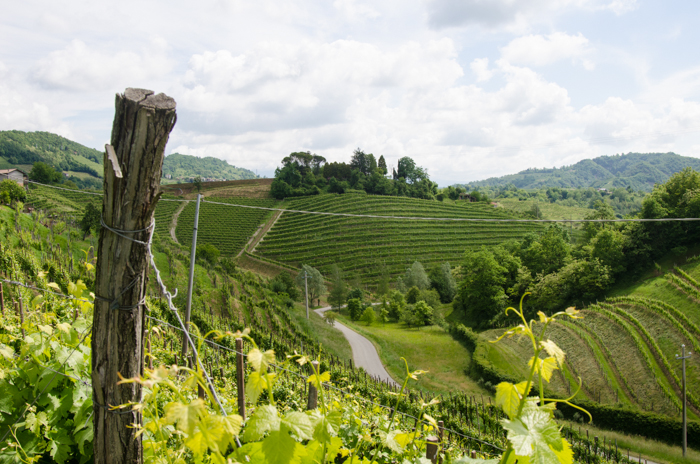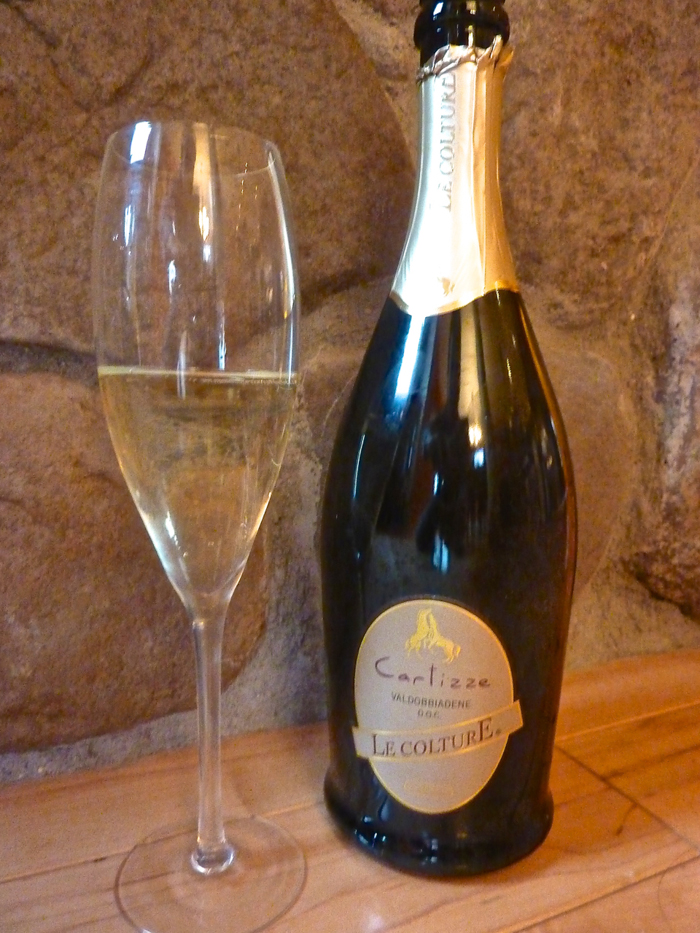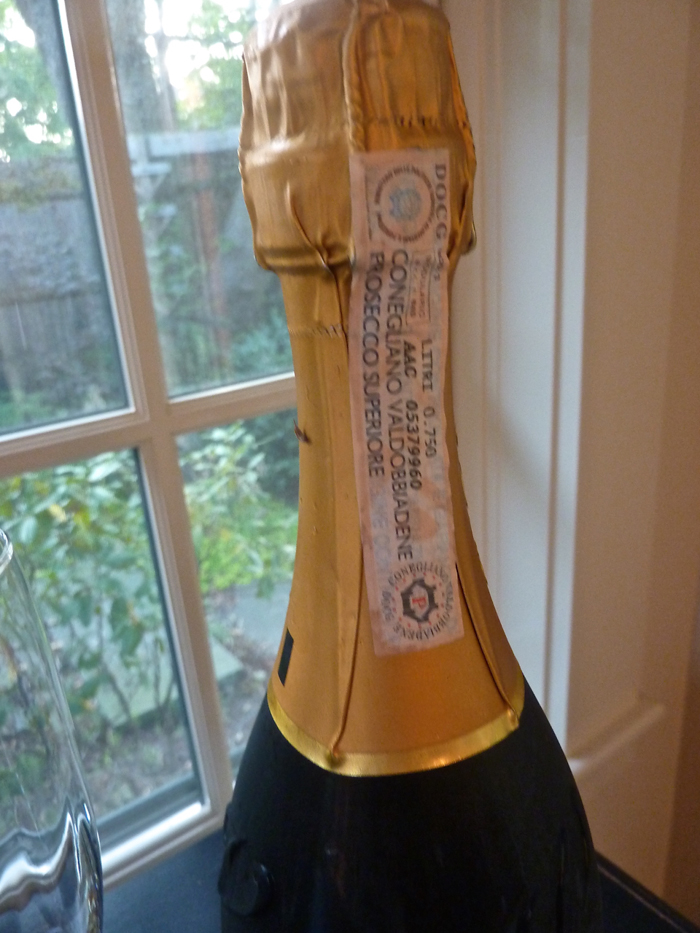Prosecco has been produced for over 10 centuries in the foothills of the Marco Trevigiana, in the province of Treviso, running from Valdobbiadene to Conegliano. This beautiful area in the foothill of the Dolomites, is home to multiple DOC and DOCG wine regions, and a region best explored by bike or foot. The origins of this wine date back even prior to the Roman colonization of the area in the 2nd century B.C.

Prosecco is reputed to be “Pucino”, a wine referred to in ancient Roman writings. It was believed to contribute to longevity. Proseccos’ renown peaked in the 15th to 17th centuries, when it was a very profitable and reliable export to Venice and the Germanic countries.
A severe frost in 1709 killed most of the prosecco vines, This forced the farmers to move to more rustic varietals, which were more robust, but resulted in poorer quality wines. The demand for prosecco suffered accordingly. It took over 100 years for the farmers to recover and return to the higher quality vines. A second series of setbacks occurred around 1900. First several blights wreaked havoc on the area, including the grape louse phylloxera. Following this, the First World War devastated the region. But post-war, the farmers were committed to recover their vineyards, which brought a transformation of the vines and viniculture of the area, and the restoration of quality in the resulting wines.

Prosecco is a sparkling wine, either spumante (full sparkle) or frizzante (light sparkle). Originally fermented in bottles, it was a somewhat sweet wine as not all of the sugars were consumed during the fermentation process. Often confused with champagne, prosecco today is produced using the Martinotti-Charmat method. In this method, the secondary fermentation occurs in a closed stainless steel tank over days, rather than in the bottle over months or years as in the Method Traditional, used to produce champagne. The wine is then bottled under continuous pressure. Named for the two inventors that contributed to the development of this process, one French, and one Italian, both countries like to claim ownership. The French Charmat was the one who perfected it and officially registered it. However, you will often see it referred to as the Metodo Italiano, especially in Italy. The bubbles in Prosecco are typically smaller and longer lasting than those found in champagne, due to this different production method. This less labor intensive and less time consuming process also makes the wine less expensive to produce. Prosecco is now growing rapidly in popularity outside of Italy, with double-digit annual growth in sales.

This dramatic growth in popularity has also brought to market many suppliers using the name “prosecco” , who are not located in the traditional hill-region that produces the best grapes, and do not adhere to the same quality standards. This dilution of the name ‘prosecco’ has become a bit of a problem, as these lesser quality wines hit the market bearing the same name, but appearing no different from the higher quality original. In an effort to combat this trend, a new quality designation was earned by the sparking wines from the original Valdobbiadene to Conegliano area – the Conegliano Valdobbiadene Prosecco Superiore DOCG (Denominazione di Origine Controllata e Garantita.) This is the highest quality designation for Italian wines. It is stricter than the DOC rating, with lower allowable yields, and a evaluation by a tasting committee before they can be bottled. This DOCG region is comprised of 15 communes, of around 20,000 hectares. The grapes are grown only on the sunny parts of these hills. Right now, only 5,000 hectares of vineyards are entered into the official DOCG register.
Proseccos from the surrounding areas in Veneto and Fruili are labeled Prosecco DOC. Proseccos from other regions in Italy are labeled with the IGT designation, indicating more of a table wine, and display a wide range of quality levels.
The original Prosecco region centered around the steep hill of Cartizze. As in all wine varietals, the more challenging the terrain, the better the wines. Forcing the roots to dig deep for nutrients and water produces the best quality grapes for wine production. The Prosecco from the Cartizze area, a small area of 106 hectares in the steepest hills of San Pietro di Barbozza, Santo Stefano and Saccol, is considered to be the best, the “Grand Cru” of Prosecco. These grapes are the last to be harvested, as they are difficult to access. The high quality of the grapes, combined with the lower yields and difficulties with cultivating here all contribute to the higher cost of these wines.

This year, a second Cru was added to the DOCG; The Rive. “Rive” indicates vineyards that are on steep ground, and indicates those grapes grown in the most challenging terroir of this region. The maximum yields are reduced to 13 tones per hectare, the grapes must be picked by hand, and the vintage must appear on the label. There are a total of 43 Rive in the Conegliano Valdobbiadene zone.
Prosecco is made from the prosecco grape, now officially referred to as Glera. The main varieties are Prosecco Bianci, Prosecco Tondo or Gentile, and Prosecco Lungo. 85% of the grapes must be of the Glera varietal. The remaining 15% is made from Verdiso, Perera and Biancheta, all local varieties that add structure to the wine. Pinot Grigio and Chardonnay may also be used. Proseccos are labeled according to the amount of sugar that remains after fermentation; the sweetest are “dry”, then “extra-dry”, with the driest versions labeled “brut”.
The various types are:
Conegliano-Valdobbiadene DOCG Prosecco Superiore – Spumante (Sparkling)
This fully sparkling wine comes the 3 versions.
Brut: the most modern and internationally popular, with both citrusy and vegetal aromas, and pairs well with seafood pastas, risottos and antipasti.
Extra dry: the traditional version, with scents of apples and pears and a mellow, but crisp palate. Excellent with pasta with light or white meat sauces, poultry, creamy cheeses, and as an aperitif.
Dry: The least common version, with a floral fruitiness. Its’ relative sweetness pairs best with either spicy foods or pastries.
Conegliano-Valdobbiadene DOCG Prosecco Superiore – Frizzante (Semi-sparkling)
This version is a bit more informal, with rich fruit and floral notes, and a fresh palate. It is a wonderful aperitif, and pairs well with simple risottos or pastas.
Conegliano-Valdobbiadene DOCG Prosecco Superiore – Tranquillo (Still)
The least common version, it actually comes from the most densely planted vineyards with the lowest yields. The grapes are harvested only when extremely ripe. A delicate straw yellow, with aromas of apples, pears, honey and almonds. It is an excellent accompaniment to seafood and antipasti.
Superiore di Cartizze and The Rive
Cartizze: Available traditionally as a fully sparkling spumante, usually Dry, some producers have now introduced a Brut version. An intense wine, with fragrances of apples, pears, apricot, citrus and rose. A full palate, with fine bubbles. It pairs wonderfully with traditional local cakes, shortbreads and fruit desserts.
The Rive: Only available as a fully sparkline spumante. New to the market this year, it remains to be seen what wonderful flavors and aromas develop!
Prosecco has an intense, immediate fruity nose and flavor, due to its youth and the Charmat production method. As it does not ferment in the bottle, it can degrade fairly quickly and should be drunk young. It is served chilled as an aperitif or an accompaniment to desserts. It is also used in the classic Bellini cocktail. Prosecco is fairly low in alcohol content compared to other wines (11-12%), and has a wonderful fresh and light flavor.
Discover more about the beautiful region where prosecco is grown, the Colli di Conegliano Wine Zone.


